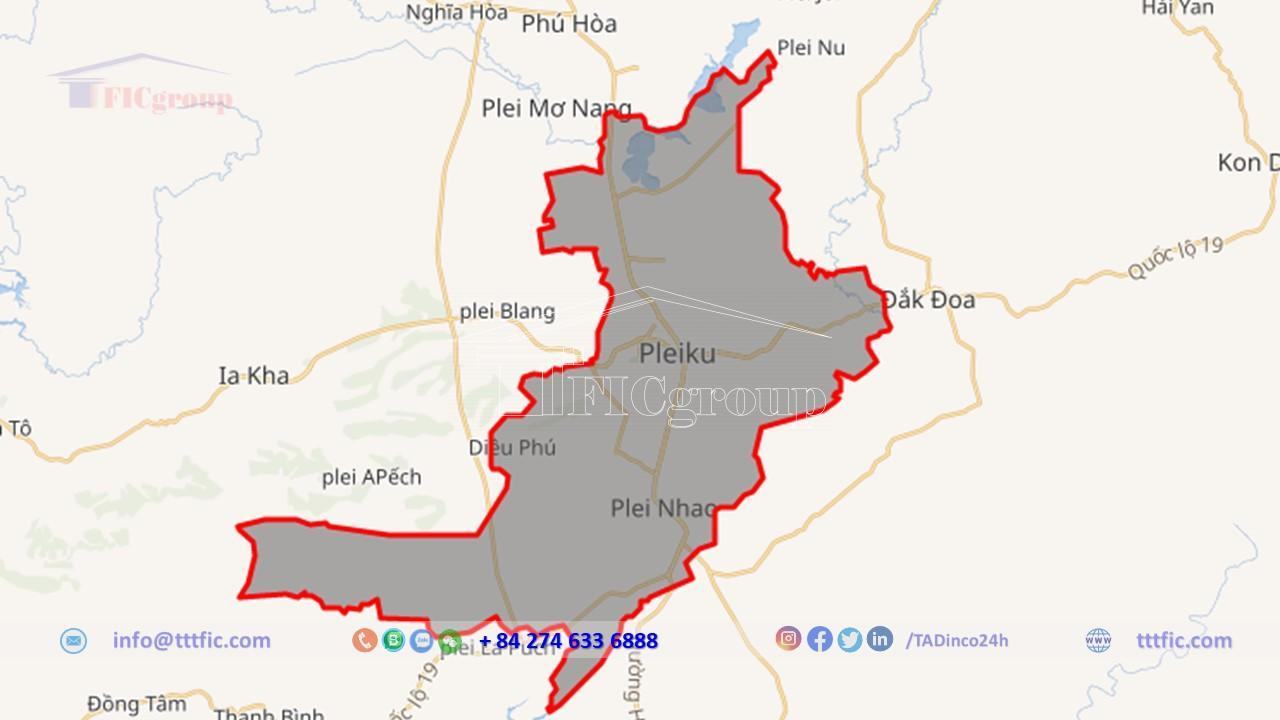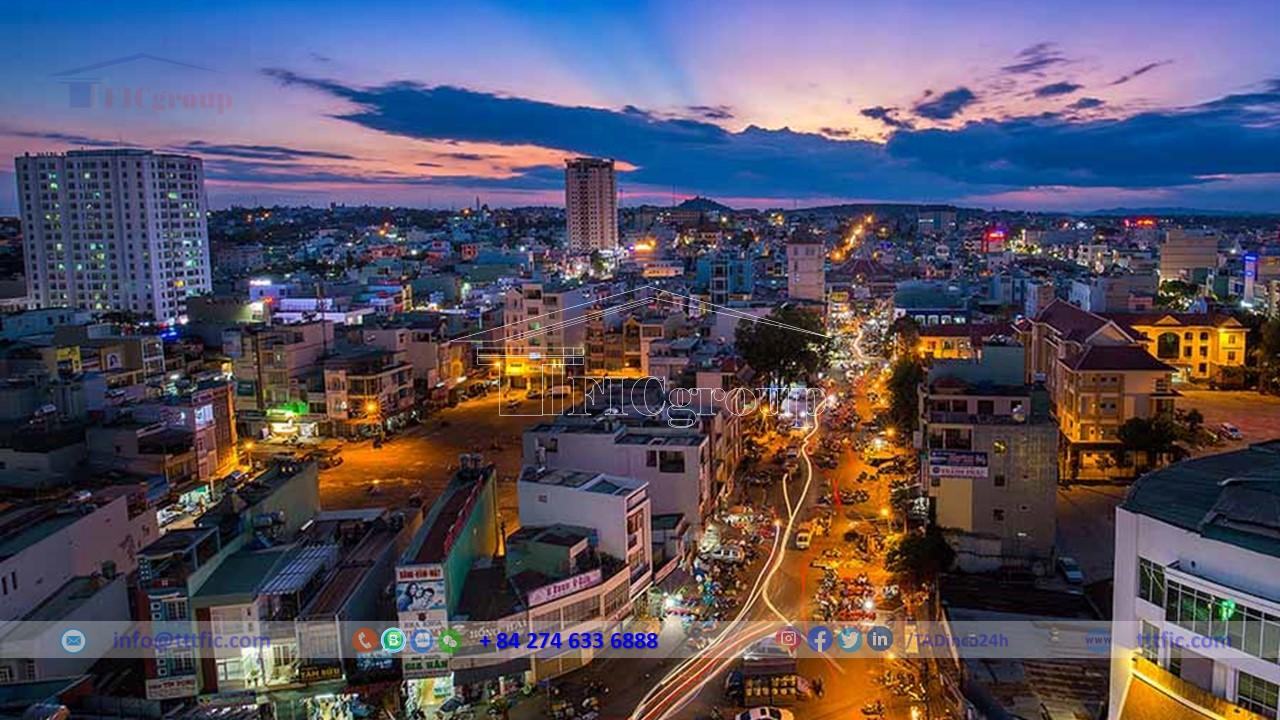
Tra Da Industrial Park - Gia Lai
- Investor: GIA LAI PROVINCE INFRASTRUCTURE DEVELOPMENT OF ECONOMIC ZONE
- Price: 50 USD/m2
- Area: 213 Ha
Gia Lai, a mountainous province in Central Vietnam, stands as the country’s second largest. It leads in size and is second in population in the Central Highlands.
As of April 2019, Gia Lai, with 1.513 million people and 374,512 households, ranks 18th in Vietnam’s population. It’s 30th in Gross Regional Domestic Product (GRDP) and 33rd in per capita GRDP growth rate. In 2020, the GRDP was VND 80,000.32 trillion, with per capita income of VND 51.9 million and a GRDP growth rate of 8.00%.
Gia Lai is a strategic defense area. It houses the headquarters of Military Region 3 and Military Corps 15.
The name ‘Gia Lai’ originated from ‘Jarai’, a minority tribe in the province. This name is still used by the Ê-đê, Ba Na, Lao, Thai, and Cambodian people to refer to this land.
Re-established on August 12, 1991, when Gia Lai – Kon Tum province split into two, Gia Lai’s capital is Pleiku city. As of April 2019, Gia Lai was home to over 34 ethnicities and five recognized religions, with the Kinh people accounting for 53.77% of the population. In central areas like Pleiku city, the Kinh are the majority (87.5%).
Gia Lai is a highland province in Northern Central Highlands, Vietnam, sitting 700-800 meters above sea level. It’s 1120 km from Hanoi, 396 km from Da Nang, and 491 km from Ho Chi Minh City.
Gia Lai extends from 12°58’20” north latitude to 14°36’30” and from 107°27’23” east longitude to 108°54’40”.. It shares a 10 km border with Quang Ngai to the northeast, mostly through the Kon Chư Răng nature reserve in Kbang district.
To the east, Gia Lai shares over 115 km of border with Binh Dinh province (Kbang, Đăk Pơ, and Kông Chro districts). The main roads between these two provinces are DT637 and Highway 19.
To the southeast, it borders Phu Yen with about 100 km of boundary, primarily in Krông Pa district and parts of Ia Pa and Kông Chro districts.
To the west, it borders Ratanakiri province of Cambodia with about 90 km of border, covering Đức Cơ and Chư Prông districts and part of Ia Grai district.
And to the south, it borders Dak Lak province, and to the north, it borders Kon Tum province.

Gia Lai sits on an ancient, vast rock bed in the Kon Tum Block. This area is part of the southern end of the Truong Son Mountain range. It is mostly east of the Truong Son range. The terrain, shaped by volcanoes and weathering, is undulating with hills and valleys.
The terrain lowers from north to south and leans from east to west. It’s a complex mix of mountains, plateaus, and valleys. Gia Lai’s terrain can be divided into mountains, plateaus, and valleys. Plateaus are common and important in Gia Lai, like Kon Ha Nung and Pleiku.
Mountainous terrain occupies 2/5 of the province, mainly in the north. The average height of the plateaus is 800m, with Kon Ka Kinh being the highest point. The diverse geological structure provides substantial groundwater. The relative lowlands form rivers and waterfalls.
Lowland areas were early exploited for food production. Most lowlands are in the south, with valleys in the southeast. Gia Lai’s soil is divided into 27 types, including alluvial, grey, black, red, yellow, and stony soils. The main type is red basalt, which is fertile and ideal for cultivation.
Gia Lai has a tropical monsoon climate with high humidity, heavy rainfall, no storms, and no salt mist. The temperature depends on the altitude.Yes, that’s correct. Gia Lai’s climate is characterized by a wet season from May to October and a dry season from November to April. The annual average temperature ranges from 22 to 25 degrees Celsius.
Gia Lai’s climate and soil are suitable for short and long-term industrial crops, livestock, and agroforestry business. The province has 27 soil types formed on various parent rocks. Mineral resources, including gold, construction materials, bauxite, and gemstones, are significant economic potentials of Gia Lai.
According to statistics provided by the General Statistics Office, the economic growth rate for the first six months of 2022 is estimated to be 6.87%. Contributions to this growth include:
Agriculture, forestry, and fishery, which increased by 5.84%
Industry and construction, which increased by 13.36% (with industry specifically increasing by 17.47%)
Services, which increased by 5.02%
However, the tax on products decreased by 9.41%.
For comparison, the growth rate for the first six months of 2021 was 9.7%, with agriculture, forestry, and fishery increasing by 4.98%, industry and construction by 24.53%, services by 2.86%, and product tax by 3.88%.
The economic situation in the agricultural, forestry, and aquaculture sectors for the first six months of 2022 is as follows:
The value of agricultural, forestry, and aquaculture production (compared to 2010 prices) is estimated to be 10,718 billion VND, reaching 31.69% of the plan and increasing by 5.93% compared to the same period. Specifically: Agriculture reached 10,469 billion VND, forestry reached 206 billion VND, and aquaculture reached 42.4 billion VND.

Farmers have planted an estimated 78,000 hectares for the Dong Xuan crop, achieving 103.3% of the plan, marking a 2.32% increase compared to the same period. They have produced an estimated total grain output of 180,136 tons, reaching 103.7% of the plan, up 4.35% from the same period.
By June 16, 2022, they had planted 140,132.7 hectares of various crops for the season, reaching 63.3% of the plan. They have effectively implemented plant disease management.
Farmers have converted a total of 820.35 hectares of land for different types of planting, ensuring that most crops are suitable for the land conditions and adaptable to climate change. This has led to high yields, good quality, and increased economic efficiency.
The province currently has about 227,176.4 hectares of crops produced following standards like VietGAP, GlobalGAP, 4C, Organic, Rainforest Alliance, FLO, with 55 designated growing areas and 21 packing facilities. There are 37,592.4 hectares of crops using advanced, water-saving irrigation technology.
Farmers have vigorously developed livestock farming in farms by applying advanced techniques in breeding, feeding, and rearing processes. Currently, 192 livestock projects are attracting investors, covering a total area of 9,219.49 hectares and a total investment capital of 29,904.39 billion VND. Authorities have granted investment policy decisions for 43 projects, and 16 projects are operational, housing 43,402 cows and 88,112 pigs.. The disease situation in livestock and poultry is relatively stable.
In implementing the 2022 forest planting plan, the plan to allocate forests to 8 districts with an area of 6,851.38 hectares has been approved. As of June 16, 2022, units and localities have planted 78.4 hectares; prepared 2,428.3 hectares for centralized forest planting and 1,289.86 hectares for scattered tree planting. The world biosphere reserve “Kon Ha Nung Plateau” continues to deploy tasks of management, conservation, ecosystem development, scientific research, and international cooperation. In the first 6 months of the year, the functional sectors inspected and detected 169 violations of the Forestry Law (down 67 cases compared to the same period); administratively handled 68 cases, criminally handled 11 cases, confiscated 122 vehicles, 271.9 m3 of various types of wood; contributing 669.5 million VND to the state budget. There have been no forest fires since the beginning of the year.
The industrial production index for the first 6 months is estimated to increase by 11.8% compared to the same period. The total value of industrial production (compared to 2010 prices) is estimated to be 12,262.2 billion VND, reaching 42.44% of the plan and increasing by 14.31% over the same period. In detail:
– The mining industry decreased by 16.04%.
– The manufacturing industry increased by 10.34%.
– The production and distribution of electricity and gas increased by 22.78%.
– Water supply, waste management, and wastewater treatment increased by 14.15% compared to the same period.
– Retail sales and service revenues reached 39,248.92 billion VND, fulfilling 46.18% of the plan, up 8.75% from the same period.
– The export turnover for the first half-year was 420 million USD, meeting 63.64% of the plan and increasing by 33.33% from the same period. The reopening of markets under new normal conditions both domestically and in European and Asian countries facilitated trade and boosted export activities. Moreover, exports increased on holidays and New Year’s Day in key markets such as the EU and the US. Agricultural commodities like coffee and rubber saw increases in both volume and value.
– Traders have imported an estimated 87 million USD worth of goods, achieving 87% of the plan. This is a decrease of 68.59% compared to the same period. (In 2021, there was a sharp increase due to the import of wind power machinery and equipment). The primary imports were production raw materials.
– Authorities have actively implemented market management work, inspection, control, and combating smuggling and trade fraud activities. They have strengthened inspection and control due to price fluctuations in gasoline, construction materials, and agricultural supplies, and promptly and strictly handled violations.

As per 2020 statistics, Gia Lai province spans 15,510.90 km², housing 1,541,829 inhabitants, with a population density of 99 people/km².
As of April 1, 2019, the population of Gia Lai reached nearly 1,513,847 people, with a density of 102 people/km². The distribution of the population is unequal: Pleiku city constitutes 27.53% of the province’s total population and has a high population density of 1662 people per square kilometer, whereas An Khe town has a population density of 408 people per square kilometer. The remaining districts and towns all have densities below 200 people/km², with K’ Bang district having a density of just 45 people/km².
Urban residents number 438,062, making up 28.9% of the province’s population, while rural residents are 1,075,785, making up 71.1%. The male population is 758,759, while females number 755,258. The natural population growth rate increased by 1.72 ‰, and the urbanization rate reached 31% by 2022.
According to the Vietnam General Statistics Office, as of April 1, 2009, Gia Lai province was home to 38 different ethnic groups, including foreigners. The Kinh ethnic group is the largest with 713,403 people, followed by Gia Rai with 372,302 people, Ba Na with 150,416 people, Tay with 10,107 people, Nung with 10,045 people, Muong with 6,133 people, Thai with 3,584 people, and Dao with 4,420 people.
As of April 1, 2019, Gia Lai province had followers of 10 different religions, numbering 397,566 in total. The largest was Catholicism with 166,996 followers, followed by Protestantism with 142,220, Buddhism with 85,229, and Cao Dai with 2,971. Other religions include Bahá’í with 59 followers, Hoa Hao Buddhism with 41, Tu An Hieu Nghia with 23, Minh Ly Dao with 18, Tinh do cu si Phat hoi Vietnam with 5, and Islam with the least at 4.
In recent years, Gia Lai’s healthcare system has gradually improved with major hospitals.
Healthcare services have expanded, more ethnic minorities are receiving medical care and health services are increasing. With big hospitals like Gia Lai General Hospital, Military Hospital 211, Military Hospital 15, and Hoang Anh Gia Lai University Hospital, patients no longer need to be transferred to higher-level hospitals like Cho Ray Hospital (Ho Chi Minh City), Da Nang Hospital (Da Nang), and Bach Mai Hospital (Hanoi). The establishment of Gia Lai Children’s Hospital has significantly improved the quality of healthcare in the province. Patients rarely need to be transferred to overcrowded hospitals like Children’s Hospital 1 (Ho Chi Minh City), Da Nang Obstetrics and Pediatrics Hospital (Da Nang), and National Children’s Hospital (Hanoi).
According to data from the Department of Health, Gia Lai province has 5 hospitals, 2 departments (Population-Family Planning and Food Safety and Hygiene), 7 preventive health centers, a secondary health school, a health appraisal center, and a project management board for health investment. There are 17 health offices, 17 district health centers, 17 population-family planning centers, and 220 wards and towns with active health services, including 208 commune health stations and 14 central commune health stations.
As of September 30, 2011, Gia Lai province has 530 general education schools, including 41 high schools, 229 junior high schools, and 226 primary schools. In addition, there are 236 kindergartens. With such a school system, the province’s education system is relatively complete, contributing to reducing illiteracy in the province.
Minh Thanh Pagoda, located in Pleiku city, exemplifies the rich potential for tourism in Gia Lai. The province boasts diverse landscapes with towering mountains, natural and man-made scenery. Pristine forests here are home to a rich flora and fauna, alongside various gorges, streams, and lakes such as T’Nung Lake, a famous attraction. Other notable sites include the Martyrs’ Memorial Shrine and Dak Po Victory Monument in Dak Po district.
The region also features many hills such as the Mang Yang Heaven Gate, Ham Rong peak, Hang Dơi waterfall, and K50 waterfall in Kbang district. Man-made landscapes include vast rubber forests, tea and coffee hills. Complementing the forest routes are riverboat tours, elephant rides through the jungle, and more.
Moreover, Gia Lai is home to the rich culture of the local ethnic groups, primarily the Gia Rai and Ba Na people. This is evident in the architecture of communal houses, stilt houses, and tomb houses, traditional festivals, and through their costumes and musical instruments.
Characteristic musical instruments of the ethnic minorities include the Gong, Lithophone, K’ni, K’long put, Goong, T’rưng, Alal, etc. Festivals like the Buffalo stabbing ceremony, New Rice ceremony, and Leaving Tomb ceremony are cultural highlights. The province also offers local specialties such as Can wine, Crispy Rice – Glutinous Rice Wine, Dry Pho (a two-bowl Pho variant), and the famous tomb statues.